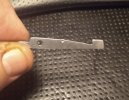I haven't posted here in a while. I have been busy making half whittlers which is my speciality. I will make any blade profiles people want though. But I made the journey to the slipjoint knife mecca today, Smoky Mountain Knife Works in Tennessee, and bought a Case half whittler and a specimen from Boker with a clip point main blade. This is the pattern with a single backspring and 2 blades that pivot on either end with the main blade full thickness and the small pen blade thinner with an extra piece of liner to make up the thickness. If there is a name for this pattern with clip point main blade and pen secondary blade, please tell me because it is a common request and I just still call it a half whittler.
What struck me upon opening the Boker was the backspring was struck while it was hot to deform the metal exactly where the blade tangs make contact. The blade tang notches were also similarly struck. This fascinated me because it reduces the filing time needed to fit the blades and spring together, and I have never noticed this technique used by any other maker. It also makes it possible to cut blank springs and blades in bulk and fit them with very little profile grinding, because you are deforming the metal in the key fitting areas and the rest stays the same.
My question is if this forum believes this extra step of heating up the parts and striking them before the heat treating step causes any undue stress to the parts? Is warping more likely? Is normalizing needed? I want to try this method if it reduces production time, but only if quality is not impacted.
I do my own heat treating starting from 02 from Amtek. I normally just stock remove and heat treat as is. A nice member here tested some coupons for me and my heat treat is optimal for this steel. I would like to keep it that way.
What struck me upon opening the Boker was the backspring was struck while it was hot to deform the metal exactly where the blade tangs make contact. The blade tang notches were also similarly struck. This fascinated me because it reduces the filing time needed to fit the blades and spring together, and I have never noticed this technique used by any other maker. It also makes it possible to cut blank springs and blades in bulk and fit them with very little profile grinding, because you are deforming the metal in the key fitting areas and the rest stays the same.
My question is if this forum believes this extra step of heating up the parts and striking them before the heat treating step causes any undue stress to the parts? Is warping more likely? Is normalizing needed? I want to try this method if it reduces production time, but only if quality is not impacted.
I do my own heat treating starting from 02 from Amtek. I normally just stock remove and heat treat as is. A nice member here tested some coupons for me and my heat treat is optimal for this steel. I would like to keep it that way.
Last edited:



